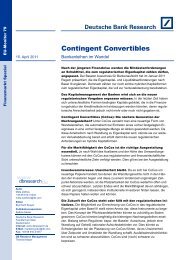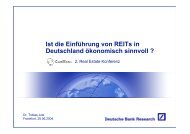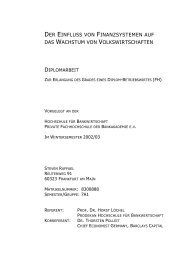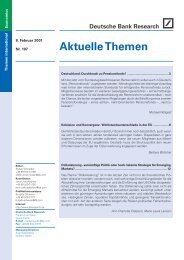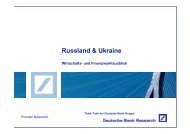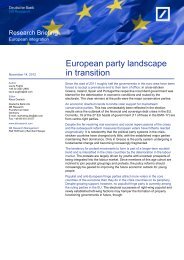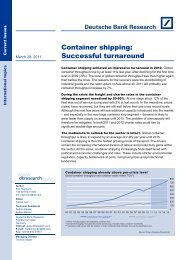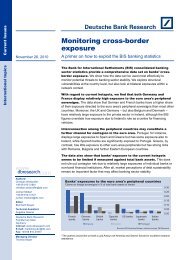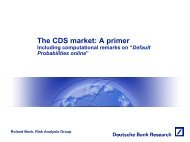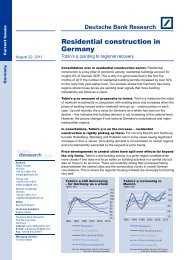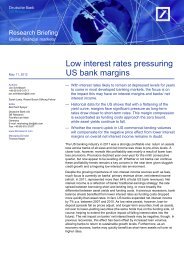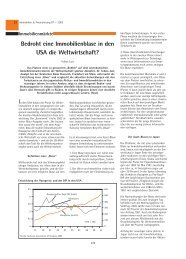Dynamic diversity opens up opportunities - Deutsche Bank Research
Dynamic diversity opens up opportunities - Deutsche Bank Research
Dynamic diversity opens up opportunities - Deutsche Bank Research
Create successful ePaper yourself
Turn your PDF publications into a flip-book with our unique Google optimized e-Paper software.
Self-employment ratio<br />
%<br />
EL<br />
IT<br />
PT<br />
PL<br />
ES<br />
CZ<br />
EU-27<br />
UK<br />
FI<br />
AT<br />
HU<br />
DE<br />
FR<br />
US<br />
LU<br />
0 10 20 30 40<br />
* EL = Greece Source: OECD 2006/2007 20<br />
<strong>Bank</strong>s finance SMEs worldwide<br />
A study conducted under the auspices of the<br />
World <strong>Bank</strong> compares the patterns of bank<br />
lending to SMEs in 45 countries.<br />
A lack of information on performance or credit<br />
history as well as inadequate amounts of<br />
collateral at start<strong>up</strong>s lead banks’ loan officers<br />
most often to harbour doubts about company<br />
creditworthiness. Established older firms, by<br />
contrast, build <strong>up</strong> a relationship with their bank<br />
over time or have a good enough credit<br />
standing or collateral to be classified as<br />
creditworthy and low-risk borrowers, and thus<br />
obtain access to loans with more favourable<br />
conditions.<br />
Over 80% of the banks in developing and<br />
industrial countries consider SME business to<br />
be a profitable undertaking. The SME market<br />
tends to be covered by domestic banks as<br />
opposed to foreign banks. <strong>Bank</strong>s view<br />
macroeconomic instability (developing<br />
countries) and/or competition (industrial<br />
countries) as the key obstacles to SME<br />
funding. The most important criteria for credit<br />
decisions are: the assessment of a company’s<br />
financial health, credit standing, personality of<br />
the owner, purpose of the loan and collateral<br />
(more important for smaller banks). The most<br />
important forms of collateral, usually, are<br />
mortgages, equity capital and personal<br />
securities. <strong>Bank</strong>s often demand higher fees<br />
and interest rates from SMEs than from large<br />
companies, but also have more overdue loans<br />
to SMEs in their portfolios. The result of the<br />
study is that the financing of SMEs is not so<br />
much a factor of their size as of the overall<br />
financing environment in their country.<br />
Source: Beck/Demirgüc-Kunt/Peria (2008): <strong>Bank</strong>ing SMEs<br />
around the World – Lending practices, business models,<br />
drivers and obstacles. World <strong>Bank</strong>.<br />
Current Issues<br />
Thus, about 56% of the self-employed operate as sole proprietors,<br />
while 44% have staff working for them 19 .<br />
The introduction of the internet immensely boosted the possibilities<br />
for the self-employed to turn a business idea into reality on a very<br />
small scale. For over ten years the self-employment ratio climbed<br />
continually in Germany before peaking, and it has declined slightly<br />
since 2006. This is partly attributable to the booming economy over<br />
the past few years which resulted in companies <strong>up</strong>ping their<br />
headcounts while reducing the number of people compelled to<br />
become self-employed for lack of alternatives, and partly to changes<br />
to the incentives for forming an ―Ich-AG‖, i.e. a ―Me plc‖. 20<br />
In the EU, the Mediterranean countries have the highest selfemployment<br />
ratios. Over 20% of the labour force is self-employed in<br />
Greece, Italy, Portugal and Romania, and thus the self-employed<br />
have a very important – and higher – macroeconomic significance<br />
than in Germany, for instance, where the self-employment ratio<br />
(around 10%) is lower than the EU average (EU-27: roughly 17%).<br />
In an international comparison there is not only a high employment<br />
effect thanks to a high self-employment ratio but moreover a positive<br />
cross-country correlation between the contribution of SMEs to<br />
employment, the share of micro enterprises, the self-employment<br />
ratio and the contribution to value added, as already indicated<br />
earlier.<br />
4.5 Access to funding is essential for an SME’s survival<br />
Access to external funding is essential for the survival of small and<br />
medium-sized enterprises since they are usually unable to prosper<br />
on equity capital alone. Various types of financing are available,<br />
although not all of them are equally recommendable for all cases.<br />
Furthermore, there is a particular focus on the equity base. The legal<br />
form of a business is of significance insofar as it plays a part in<br />
decisions regarding the availment of various types of financing<br />
instruments.<br />
Legal form – the relationship between ownership and risk<br />
The particular relationship between ownership and performance, or<br />
liability and risk, is perhaps the crucial difference between SMEs<br />
and large corporations. 21 For this interlinkage is also reflected in<br />
company policy decisions and thus shapes funding requirements.<br />
Whether a company is risk averse or risk tolerant hinges in many<br />
cases on the personality of the owner or owners � and of course on<br />
its equity cushion.<br />
In Germany, an SME is typically set <strong>up</strong> in the legal form of the sole<br />
propietorship, and its owner is in most cases also the company’s<br />
chief executive. Of the nearly 700,000 new firms registered in 2007,<br />
some 81% were sole proprietorships, 12% were launched as a<br />
private limited-liability company (GmbH) and 5% constituted a Civilcode<br />
company (GbR). 22 While companies set <strong>up</strong> as partnerships do<br />
not need to have a minimum capital stock in view of the owners’<br />
19 OECD, Eurostat, IfM Bonn.<br />
20 Germany’s unemployed may apply for a government subsidy to set <strong>up</strong> an ―Ich-<br />
AG‖. This funding is designed to pave the way to becoming self-employed and<br />
establishing a business.<br />
21 Grichnik, Dietmar (2003). Finanzierungsverhalten mittelständischer Unternehmen<br />
im internationalen Vergleich. In Kienbaum/Börner. Neue Finanzierungswege für<br />
den Mittelstand. Dusseldorf.<br />
22 German Federal Statistical Office (2008). Neugründungen im Jahr 2007,<br />
http://www.destatis.de<br />
14 April 15, 2009



